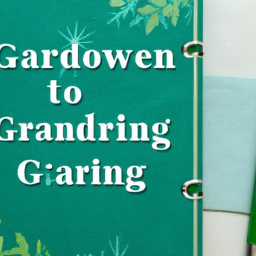How To Keep A Gardening Journal A Beginners Guide
Table of Contents []
How To Keep A Gardening Journal
Introduction
Gardening can be a fantastic activity for anyone looking to get outside and spend some quality time with the environment. By keeping a gardening journal, you can greatly enhance this experience by documenting the journey. From successes to failures, a journal helps you capture the joy and learning that comes from being a gardener. Here are 8 to 12 topics that will help you understand the benefits of keeping a gardening journal plus some advice for how best to record each.
Soil Composition
Understanding the composition of the soil you are gardening in is fundamental for success. In your journal, record the characteristics of your soil such as fertility, drainage, texture, etc. Make sure to use the USDA chart to help classify the soil into one of seven types: sand, loam, silt, clay, peat, humus, and chalk. Knowing this information will help inform your decision on what kind of plants should be grown in which parts of your garden and should be updated throughout the year.
Fertilization and Compost
Fertilizing and composting in the garden is a great way to improve the quality of soil and maximize its potential. With your journal, record the type of fertilizer you have used and any home-made compost used. Keep track of how and where you applied the compost, such as digging it into deeper areas of the soil or spreading it across the surface, and take note of when you applied it. This information will come in handy in future seasons to see what parts of the soil responded best and which soils worked best with which fertilizers.
Seeds and Plants
Every gardener will need to consider when to sow the seeds, what varieties of plants to grow, and how to prepare them. Make sure to record this information in your journal, keeping details such as when the seed was planted, what type of seeds, and even any precutting, hedging, or shaping that was done. Include any big picture notes into the mix, such as transfer of seedlings between beds and how they have been spaced.
Pest Control
Pests can be a real menace to gardens, damaging delicate plants and leaving those in charge feeling helpless. Recording any pest control procedures in your journal is an important way to understand what works and what does not. Note the type of pests you have seen in your garden, whether you used a naturally-derived treatment or a chemical one, and when it was applied. This information will provide a clear idea of the effectiveness of different treatments and help guide pest control choices in the future.
Harvest
The moment that we have all been waiting for! When the fruits of your labour have finally ripened, you want to make sure to track this progress. Make a note in your journal of when your harvestable items reach optimum ripeness and jot down the specific date when you have harvested your crop. Insert notes on the amount of produce gathered, any crop rotation between beds, and the quality of the final product.
Watering
Watering your plants is a key part of gardening, and one that you want to be mindful of when journaling. Record how often and how frequently you watered each bed of plants, and note the quality and amount of water being used. Don't forget to record the kind of watering system being used, such as a sprinkler or hose, and any times that you might have altered the manual inputs (such as additional watering during drought periods).
Environmental Factors
Be sure to keep track of the usual weather information such as temperature, precipitation, and amount of sunlight. Make notes in your journal of the wind strength and any pest influx that might have taken place. Pay special attention to any major weather events that might have had an impact, such as hail, wind storms, and extreme heat or cold events.
Soil Amendments
Any soil amendments that you use, such as manure, fishmeal, and lime, should be noted in your journal. Keep track of the type of additives used, where and how they were applied, and when they were introduced. Recording this information can help you assess the success of each amendment and compare the differences between them.
Summary
A gardening journal can be a great companion to any gardening endeavour. Here we have outlined 8 to 12 topics to guide you in recording important information in your journal. Consider keeping track of the soil composition, the type of fertilization and compost used, the kind of seeds planted, pest control information, harvest data, watering information, environmental factors, and soil amendments. Keeping track of all this information will help you make informed decisions for future seasons and provide invaluable insight into the hobby of gardening.

Previous Page
Next Page
